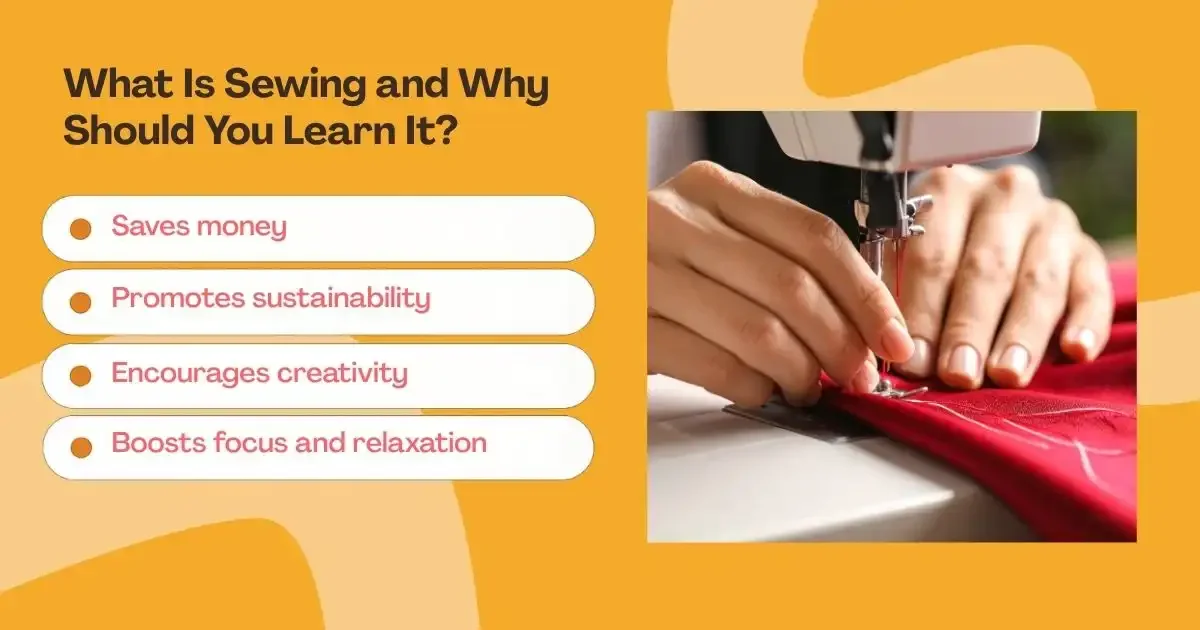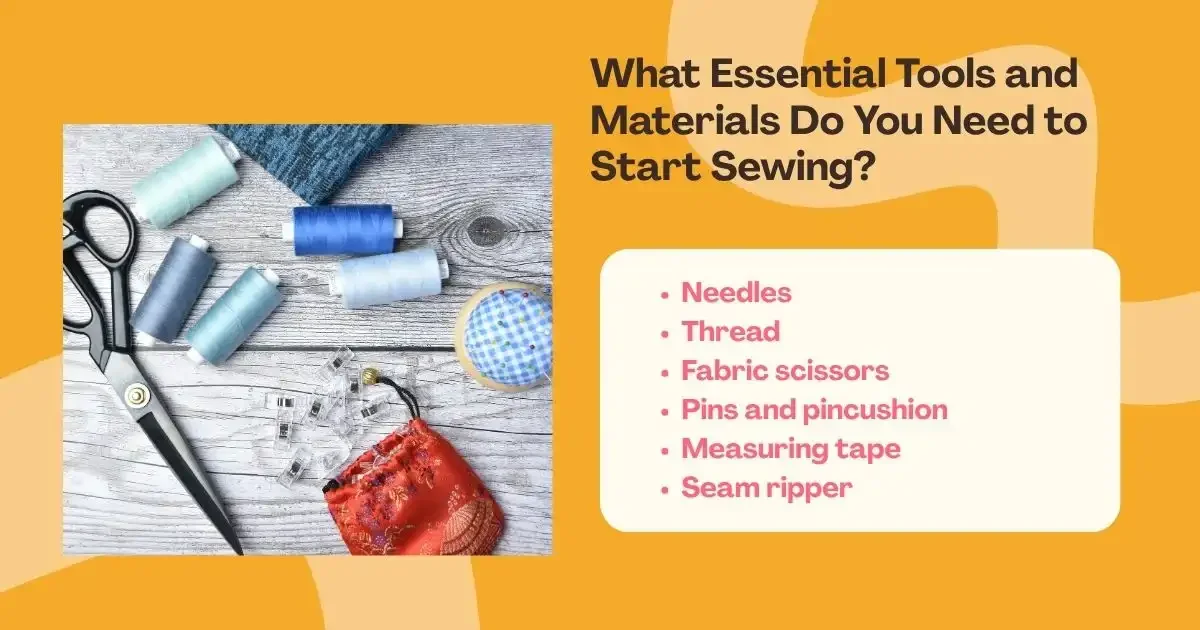Sewing for Beginners: Your Complete Starter Guide
Sewing for beginners is all about learning how to sew and understanding the sewing basics: from handling fabrics and tools to practising simple stitches and easy projects. Start with cotton fabric, practise straight seams, and try beginner projects like tote bags or pillowcases to build confidence.
Starting out in sewing can feel like stepping into a maze of fabrics, threads, and tools. It’s exciting, yet completely overwhelming. Many beginners simply don’t know where to begin or which materials are best to start with. Between choosing a sewing machine, picking the right fabric, and figuring out what supplies you actually need, it’s easy to lose confidence before you’ve even threaded your first needle.
Learning how to sew step by step is the key to overcoming that initial confusion. So, how do you move past that uncertainty and start sewing your very first project with ease and confidence?
What Is Sewing and Why Should You Learn It?
Sewing is the craft of stitching fabric pieces together using a needle and thread, either by hand or with a sewing machine. Beyond being a creative outlet, sewing is also a valuable life skill, making learning how to sew both practical and enjoyable.
Here’s why many beginners love it:
Saves money: You can repair or upcycle old clothes instead of replacing them.
Promotes sustainability: Making your own clothes reduces waste and supports slow fashion.
Encourages creativity: Sewing lets you customise designs, fit, and fabric choices.
Boosts focus and relaxation: Many find it meditative and rewarding.
Whether you dream of crafting a simple tote bag or designing your own dress, learning how to sew is a skill that grows with you.
What Essential Tools and Materials Do You Need to Start Sewing?
Before diving into your first project, it’s important to have the right tools. A beginner’s sewing kit doesn’t need to be expensive, just practical. Knowing the sewing basics and having the right equipment make your first attempts much smoother.
Basic Sewing Tools
Needles: Have both hand-sewing and machine needles in various sizes.
Thread: Cotton or polyester threads are ideal for beginners.
Fabric scissors: Use these only for fabric to keep them sharp.
Pins and pincushion: To hold fabric pieces together before stitching.
Measuring tape: For accurate cutting and fitting.
Seam ripper: Mistakes happen: this tool helps fix them.
Optional But Helpful Additions
Iron and ironing board: Pressing seams helps your work look professional.
Fabric chalk or markers: For marking patterns and seam lines.
Thimble: Protects your fingers during hand sewing.
These tools will help you build your sewing skills and practice sewing techniques for beginners efficiently.
How Do You Set Up Your Sewing Space?
A dedicated sewing area keeps you organised and motivated. You don’t need a studio, even a small desk or corner can work if set up well.
Lighting: Natural light is best, but a bright desk lamp will help too.
Storage: Use clear boxes or baskets for threads, fabrics, and notions.
Machine placement: Keep your sewing machine stable on a flat surface.
Cutting area: A separate space for measuring and cutting fabric saves time.
Creating an efficient, clutter-free sewing space helps you focus on getting started sewing.
How Do You Use a Sewing Machine for the First Time?
If you’ve never touched a sewing machine before, it might seem intimidating, but it’s easier than it looks once you understand sewing basics.
Getting Familiar with the Machine
Most machines have the same key parts:
Bobbin: Holds the lower thread.
Presser foot: Keeps fabric in place while sewing.
Feed dogs: Move the fabric forward.
Tension dial: Adjusts how tight or loose the thread is.
Step-by-Step for Beginners
Read the manual: Each model has unique threading paths.
Thread the upper and lower thread: Follow the guide carefully.
Test on scrap fabric: Check stitch tension before working on your project.
Start slow: Use the foot pedal gently to control speed.
Once you’ve mastered threading, adjusting tension, and sewing straight lines, your sewing skills will improve quickly.
What Are the Basic Stitches Every Beginner Should Learn?
Understanding basic stitches helps you complete most simple projects. Here are a few to master first:
Running stitch: The simplest stitch, ideal for basting or gathering.
Backstitch: Strong and durable for seams.
Zigzag stitch: Great for finishing raw fabric edges to prevent fraying.
Overcast stitch: Helps secure edges when you don’t have a serger.
Practising these sewing techniques for beginners will build confidence and give you a solid foundation.
What Are Some Easy Sewing Projects for Beginners?
Your first projects should be small, simple, and rewarding, helping you apply sewing basics while building confidence.
Great Starter Projects
Tote bag: Teaches straight stitching and simple seams.
Pillowcase: Perfect for practising hemming and fabric cutting.
Fabric scrunchies: A quick, stylish project that uses small fabric scraps.
Apron: A fun introduction to sewing curves and attaching straps.
These projects are ideal for learning how to sew and testing your sewing machine guide for beginners.
What Common Sewing Mistakes Should Beginners Avoid?
Even the most experienced sewers started with errors. The key is learning from them. Here are a few common beginner mistakes and how to avoid them:
Skipping fabric prep: Always wash and iron fabric before cutting.
Ignoring tension settings: Incorrect tension can cause loops or puckering.
Not pinning fabric properly: Misaligned pieces lead to uneven seams.
Rushing through cuts: Take time to measure twice and cut once.
Remember, learning how to sew is about patience and practice.
How Can You Practice and Improve Your Sewing Skills?
The more you sew, the more you’ll improve your sewing skills.
Join a class: Hands-on sewing lessons for beginners like those at Cotton Club offer guided support.
Watch online tutorials: Step-by-step videos teach sewing techniques for beginners.
Keep a sewing journal: Record patterns, settings, and lessons.
Experiment with fabric types: Try knits or denim as you advance.
Regular practice will make learning how to sew feel natural.
Where Can You Find Sewing Resources and Inspiration?
Access to good resources helps with getting started sewing:
Sewing blogs: Offer tutorials, patterns, and community advice.
YouTube channels: Free lessons covering everything from threading to garment making.
Local classes: Cotton Club offers hands-on sewing lessons for beginners in East Grinstead.
Sewing books: Titles like The Sewing Book by Alison Smith are excellent references.
Exploring patterns, colours, and materials will improve your sewing skills and creativity.
Start Your Sewing Journey Today!
Learning how to sew is less about perfection and more about progress. Every uneven stitch, tangled thread, or mismatched seam is part of the process. The more you practise, the more natural it becomes, from threading a needle to completing your first project.
If you’re ready to put what you’ve learned into practice, take the next step with a hands-on course. Cotton Club’s sewing lessons for beginners provide practical guidance, friendly support, and fun projects to build confidence and enhance your sewing skills. Browse our available Sewing Courses for Adults & Kids to find one that fits your skill level and goals. You can book your course at cottonclubsew@hotmail.co.uk or calling 07738858158. Start learning how to sew today and turn your first stitches into lasting creativity.
Frequently Asked Questions for Sewing
What are sewing items called?
Sewing items are called notions: small accessories and tools like buttons, zips, needles, thread, pins, and elastic used to complete or aid sewing projects.
What is the best material for sewing?
The best materials for beginner dressmakers are easy-to-handle fabrics like cotton lawn, poplin, medium-weight cotton, chambray, denim, linen, and canvas.
What are the five classifications of sewing?
The five classifications of sewing equipment are measuring, cutting, marking, stitching, and pressing. Each tool serves a specific purpose to make sewing accurate and efficient.
What are the two main types of sewing?
The two main types of sewing are hand stitching and machine stitching, each used for different purposes like garment making, embroidery, and finishing.





